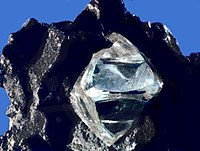
Photo from wikipedia
Developing an efficient catalyst to upgrade 5-hydroxymethylfurfural (HMF) to high value-added downstream chemicals is of great significance in biomass conversion. Three crystal-faces controllable nanorod (110)-, nanocube (100)- and nanooctaheron (111)-… Click to show full abstract
Developing an efficient catalyst to upgrade 5-hydroxymethylfurfural (HMF) to high value-added downstream chemicals is of great significance in biomass conversion. Three crystal-faces controllable nanorod (110)-, nanocube (100)- and nanooctaheron (111)- CeO2 supported Au nanoparticles have been prepared to investigate the intrinsic effect of CeO2 crystal faces on the oxidation of HMF to 2, 5-furandicarboxylic acid (FDCA). The experimental results and density functional theory calculation revealed that the concentration of oxygen vacancy (VO ) for exposed specific crystal faces was crucial to the oxygen adsorption ability, and Au/nanorod-CeO2 possesses the highest VO concentration promoted the formation of more oxygen active species (superoxide radical) on CeO2 (110) crystal face than (100) and (111) crystal faces. Besides, the higher VO concentration can provide a strong adsorption ability of HMF, greatly boosting the activation of HMF. Thus, these results led to a superior catalytic activity for the HMF oxidation over Au/nanorod-CeO2 (with the FDCA yield of 96.5%). In-situ FTIR test uncovered the HMF oxidation pathway, and the possible catalytic mechanism was proposed. A deep insight into the role of regulation for crystal faces provides a basis for the rational design of the highly active facets for the oxidation of HMF and related reactions.
Journal Title: ChemSusChem
Year Published: 2021
Link to full text (if available)
Share on Social Media: Sign Up to like & get
recommendations!